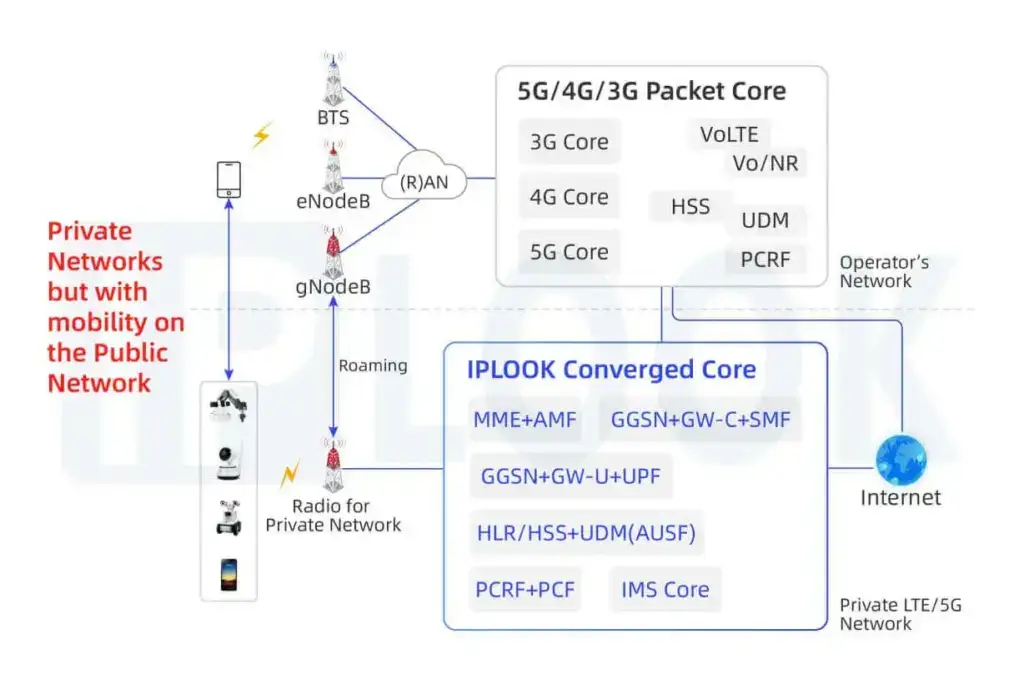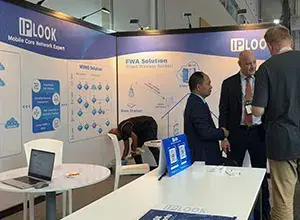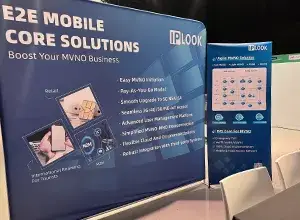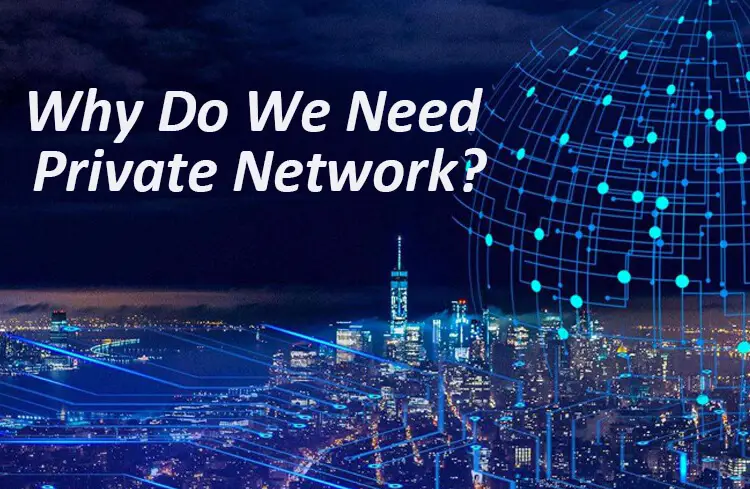Private LTE Solution

Challenge of Private Wireless Network Connection
Poor Coverage
Weak wireless signals in large indoor and outdoor areas lead to delays in data transmission and negatively impact productivity.
Unreliable Qos
Critical business applications demand stable bandwidth and low latency, which traditional networks often fail to guarantee.
Mobility lssues
Mobile devices, high-speed robots, and vehicles often lose connection, reducing operational efficiency.
Insufficient Securitv/Control
Wi-Fi lacks robust security measures, making it difficult for enterprises to fully enforce network policies.
High TCO
Wi-Fi requires additional devices due to its limited range, and outdoor deployments can be costly.
Lack of Future Application Support
Technologies such as autonomous vehicles and HD surveillance require higher network reliability.
Wi-Fi vs. Private 5G vs. Public 5G
Private 5G
- Dedicated licensed/shared spectrum, up to 10 Gbps
- Customized coverage (indoor/outdoor), strong penetration for industrial environments
- Seamless mobility (<10ms handover), supports high-speed AGVs/drones
- End-to-End Encryption + Physical Isolation, SIM-based authentication
- Deterministic Networks: <1ms ultra-low latency, 99.99% reliability in industrial scenarios
- Hybrid Network Capabilities: Multi-band (mmWave/Sub-6GHz)
- Long-term ROI: 40% lower TCO over 5 years vs. Wi-Fi, supports 100k+ devices per cell
Wi-Fi
- Unlicensed bands (2.4/5/6 GHz), up to 9.6 Gbps
- Short-range (50-100m indoors), highly susceptible to interference
- High roaming latency (>100ms), suitable for static/low-speed scenarios
- WPA3 encryption, vulnerable to MITM attacks, relies on firewalls
- High-density access but suffers from channel contention
- Limited to small indoor areas, 80% signal loss in metal/concrete environments
- Low per-AP cost but high density requires overlapping devices (~¥100k/1k㎡)
Public 5G
- Licensed operator spectrum (Sub-6GHz/mmWave), up to 20 Gbps (mmWave)
- Wide-area coverage (1-5km), limited indoor penetration without small cells
- Optimized for mobility (up to 500km/h), but indoor coverage requires enhancement
- IMSI-based SIM authentication, security policies controlled by operators
- QoS degradation during congestion (e.g., peak-hour base station overload)
- Dependent on macro base stations, indoor deployment costs increase 30-50%
- Pay-per-use data plans, high IoT traffic costs (~¥10k/month for 1k nodes)
Features and Capabilities
IPLOOK Wireless Private LTE offers a comprehensive, service-driven, and mission-critical End-to-End architecture designed to improve autonomy, enhance operational efficiency, and ensure personnel safety.
Key Components include
Integrated LTE Network
Reliable LTE connectivity for vessels, rigs, platforms, and M2M (Machine-to-Machine) applications.
Wide Coverage & Capacity
Small and macro cells to ensure strong connectivity in remote areas.
Centralized Management
A unified system for efficiently managing the network and connected devices.
Enhanced coverage, greater capacity, and better control over your business’s network
- We have a great deal of experience in deploying private cellular networks with specialized requirements. Our highly scalable and flexible deployment architecture enables Private LTE/5G networks of all sizes.
- We work closely with our customers(suppliers or integrators who offer private LTE networks for manufacturers, public entities or enterprises) to deploy their own LTE/5G network with lower costs, high security and better coverage. (e.g. bringing coverage to remote areas or ensuring mission-critical communications).
- Our solution provides the enterprise with a much higher level of control over services, including the opportunity to deploy additional services, such as IoT, which may not be implemented within the public network.
Flexible Deployment
- A trusted and proven software-based core network platform that can be deployed on COTS (Commercial Off-The-Shelf) hardware or public clouds, offering cost efficiency. Our EPC/5GC supports all radio vendors and is designed to deploy Private Networks.
- It tracks and manages users and devices on a Private LTE/5G network, while also administering data sessions. Additionally, it provides access to external networks, such as local enterprise networks or the internet.
- Integrated solutions for 4G/5G networks: These networks can operate in isolation, allowing the company to maintain full physical ownership and control over all on-premise components, without depending on external data centers.
Powering Dedicated LTE Networks Across All Industries

UTILITIES

OIL & GAS

WATER DEPARTMENT

MINING

PUBLIC SAFETY

HOSPITAL
FAQ
FAQ will answer common questions, help understand deployment, advantages, and problem-solving solutions
How can a Private LTE Solution enhance our company's competitiveness and business value?
A Private LTE solution offers a tailored, high-performance network that ensures high availability, low latency, and enhanced security. This enables companies to boost operational efficiency, protect sensitive data, and reduce dependence on external providers, ultimately fostering innovation and gaining a competitive edge.
Which industries and use cases can benefit from Private LTE?
Private LTE is ideal for industries such as manufacturing, logistics, mining, and energy. lt supports use cases like automated production, smart warehousing, remote monitoring, and HD video analytics, enabling digital transformation and lndustry 4.0 adoption.
What are the key benefits of a Private LTE Solution?
- Enhanced Security: Private LTE creates a secure, isolated network environment, ensuring sensitive business data is protected from external threats and unauthorized access. Ideal for industries such as healthcare, finance, and manufacturing where data privacy is crucial.
- Extended Coverage: Unlike Wi-Fi, Private LTE can cover large outdoor areas, multi-building campuses, or remote locations, providing consistent connectivity across vast distances—perfect for industrial parks, smart campuses, and large enterprises.
- Unmatched Reliability: Designed to deliver stable performance even in high-traffic, high-demand environments, making it the ideal choice for mission-critical operations such as public safety networks, smart grids, and industrial automation.
- Low Latency & High Bandwidth: Private LTE offers real-time communication and high-speed data transfer, supporting bandwidth-intensive applications like IoT, video surveillance, and AR/VR solutions, crucial for sectors such as logistics, security, and healthcare.
- Complete Network Control: Empower businesses to fully manage, monitor, and optimize their network, ensuring flexibility and customizability to meet specific operational needs. Perfect for companies that require full control over their data flow and network performance.
What is the difference between Private LTE and Wi-Fi, and why should I choose Private LTE?
- Coverage and Range:
- Private LTE: Provides wide-area coverage, ideal for large campuses, outdoor environments, and hard-to-reach areas. It offers more reliable connectivity over long distances, making it suitable for large factories, ports, or outdoor infrastructure.
- Wi-Fi: Typically designed for short-range use, Wi-Fi is best suited for smaller, indoor environments such as offices or homes. Its range is limited and can suffer from interference, especially in crowded or large spaces.
- Capacity and Performance:
- Private LTE: Can handle a larger number of connected devices with consistent high performance. It offers better quality of service (QoS), ensuring that critical applications (e.g., industrial control systems, emergency communications) get priority and that network congestion is minimized.
- Wi-Fi: While Wi-Fi can support many devices, its performance often degrades with high traffic or in congested environments. It may not be reliable enough for mission-critical applications that require high bandwidth and low latency.
- Security:
- Private LTE: Provides robust security features, such as advanced encryption, private access control, and isolation from public networks. It is ideal for businesses requiring secure and isolated communications, such as those in healthcare, finance, or government sectors.
- Wi-Fi: Wi-Fi networks can be less secure, especially when not properly configured. While WPA3 encryption has improved security, Wi-Fi is still more vulnerable to unauthorized access and interference compared to LTE.
- Reliability:
- Private LTE: Known for its reliability, private LTE networks are designed to maintain connectivity in environments where Wi-Fi may struggle. They can support industrial applications that require constant connectivity, even in harsh or remote locations.
- Wi-Fi: Although Wi-Fi is generally stable for everyday use, it may not perform as well in challenging environments like large factories, warehouses, or remote areas where physical obstacles or interference are common.
- Scalability:
- Private LTE: Easily scalable to meet growing demands. Private LTE networks can handle thousands of devices and can be expanded by adding more cells or integrating with other networks, making them suitable for businesses that plan to grow or deploy IoT devices at scale.
- Wi-Fi: While Wi-Fi networks can be expanded with additional access points, it may become more difficult to maintain performance as the number of users or devices increases. High-density environments may require complex configurations and additional equipment to manage traffic.
- Private LTE: Provides wide-area coverage, ideal for large campuses, outdoor environments, and hard-to-reach areas. It offers more reliable connectivity over long distances, making it suitable for large factories, ports, or outdoor infrastructure.
- Wi-Fi: Typically designed for short-range use, Wi-Fi is best suited for smaller, indoor environments such as offices or homes. Its range is limited and can suffer from interference, especially in crowded or large spaces.
- Private LTE: Can handle a larger number of connected devices with consistent high performance. It offers better quality of service (QoS), ensuring that critical applications (e.g., industrial control systems, emergency communications) get priority and that network congestion is minimized.
- Wi-Fi: While Wi-Fi can support many devices, its performance often degrades with high traffic or in congested environments. It may not be reliable enough for mission-critical applications that require high bandwidth and low latency.
- Private LTE: Provides robust security features, such as advanced encryption, private access control, and isolation from public networks. It is ideal for businesses requiring secure and isolated communications, such as those in healthcare, finance, or government sectors.
- Wi-Fi: Wi-Fi networks can be less secure, especially when not properly configured. While WPA3 encryption has improved security, Wi-Fi is still more vulnerable to unauthorized access and interference compared to LTE.
- Private LTE: Known for its reliability, private LTE networks are designed to maintain connectivity in environments where Wi-Fi may struggle. They can support industrial applications that require constant connectivity, even in harsh or remote locations.
- Wi-Fi: Although Wi-Fi is generally stable for everyday use, it may not perform as well in challenging environments like large factories, warehouses, or remote areas where physical obstacles or interference are common.
- Private LTE: Easily scalable to meet growing demands. Private LTE networks can handle thousands of devices and can be expanded by adding more cells or integrating with other networks, making them suitable for businesses that plan to grow or deploy IoT devices at scale.
- Wi-Fi: While Wi-Fi networks can be expanded with additional access points, it may become more difficult to maintain performance as the number of users or devices increases. High-density environments may require complex configurations and additional equipment to manage traffic.
Contact Us
Contact Details
- E-mail: sales@iplook.com
- Phone: +864008507700
- WhatsApp: +8618529209966
Social Media Platforms











